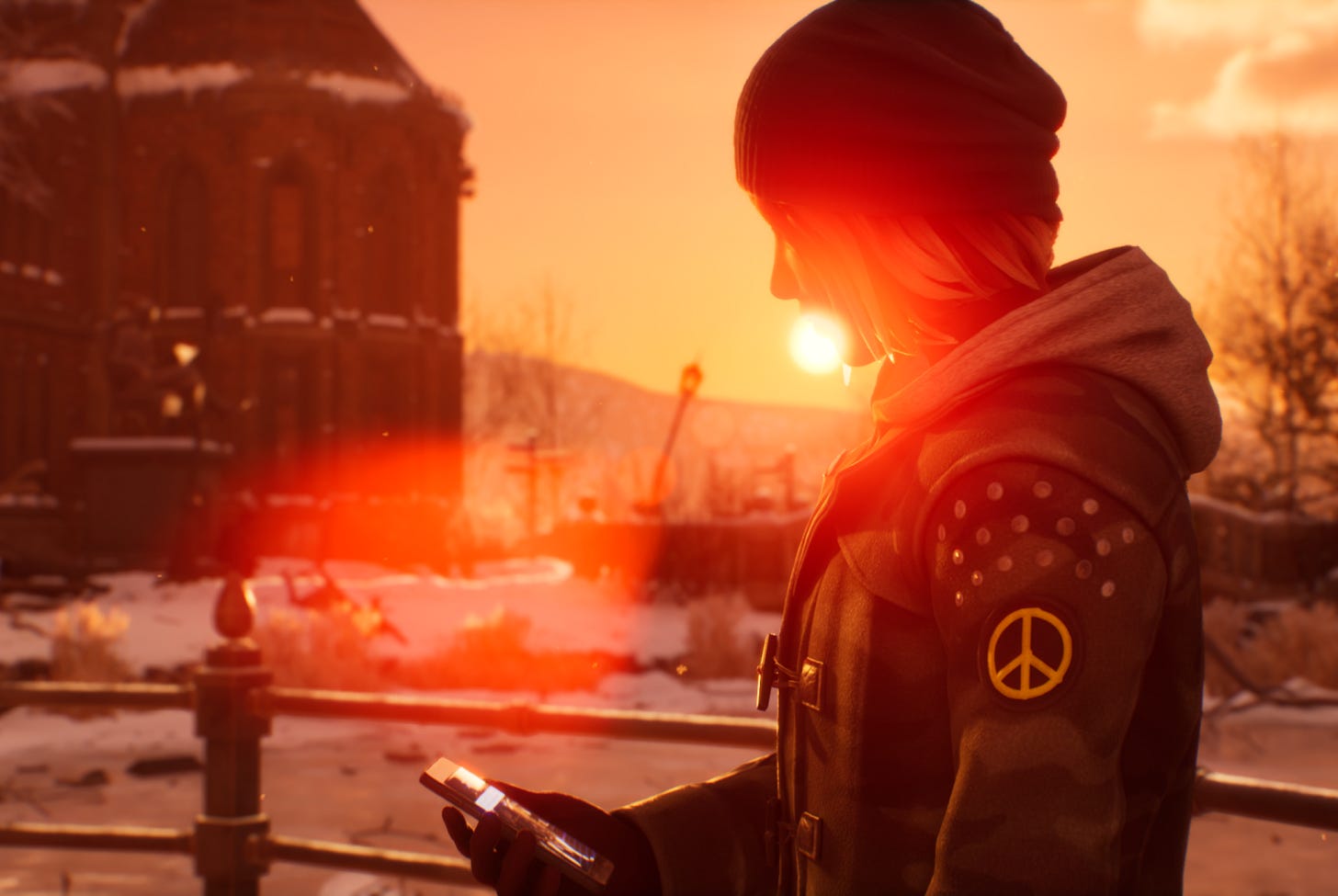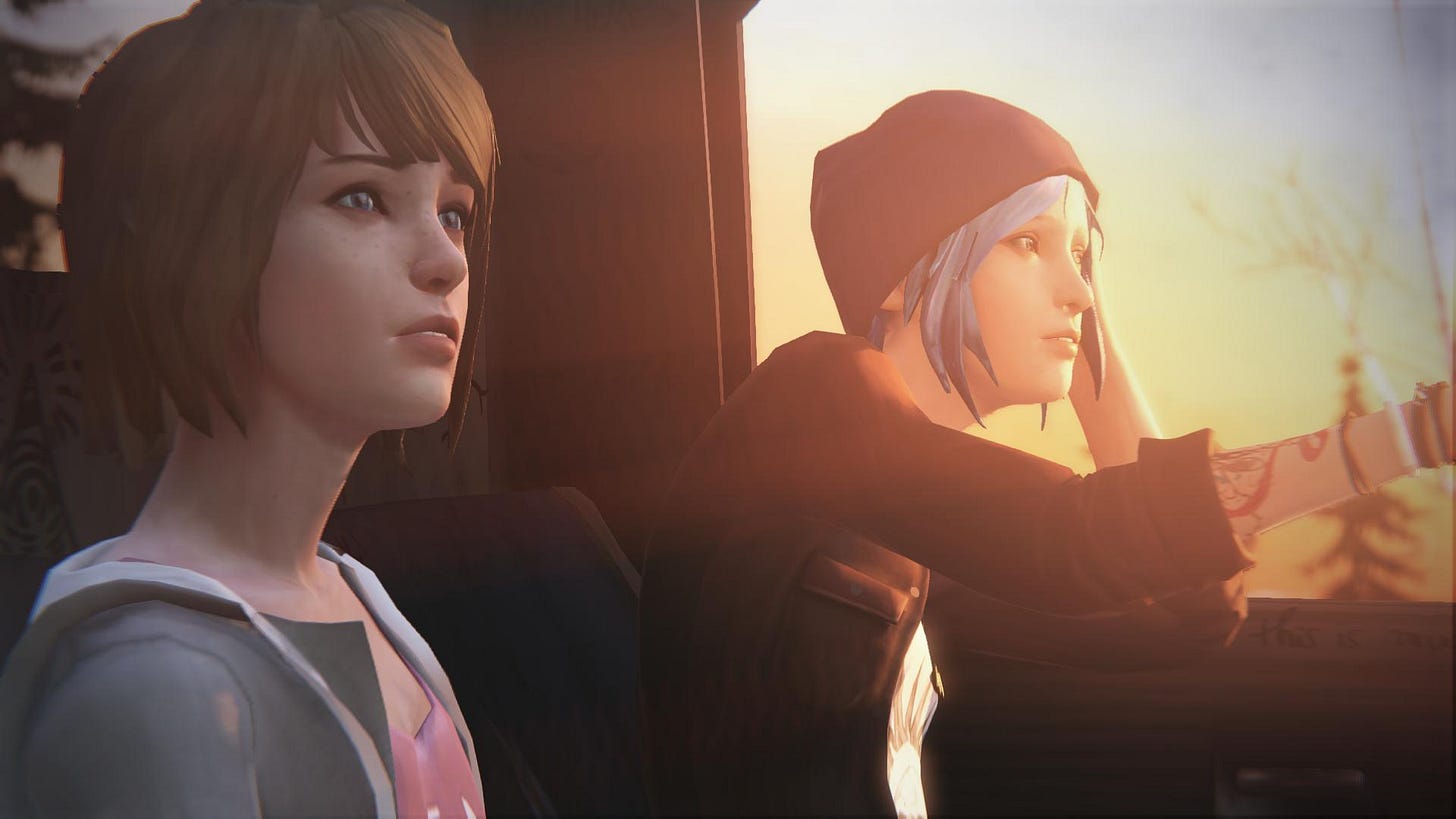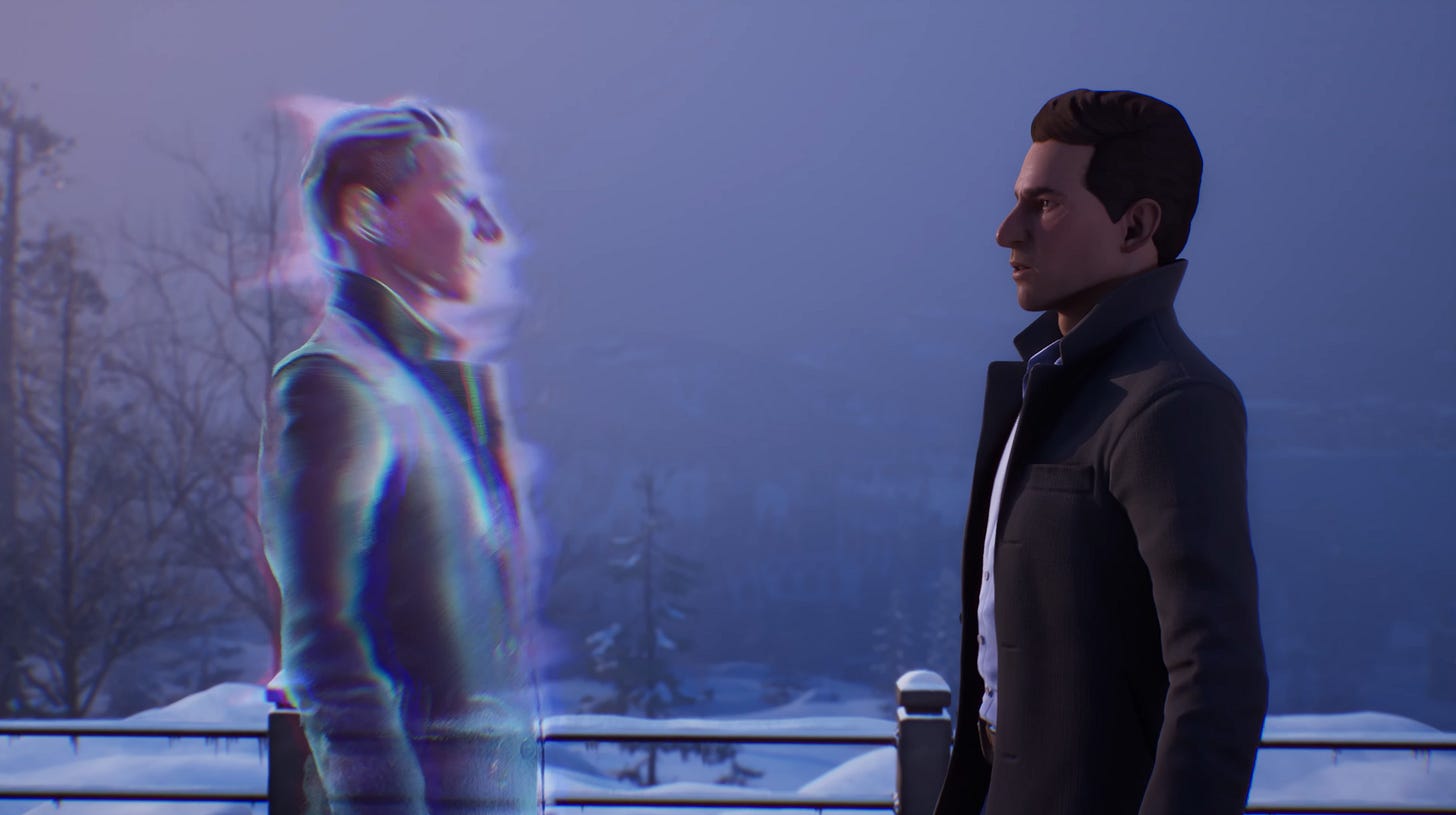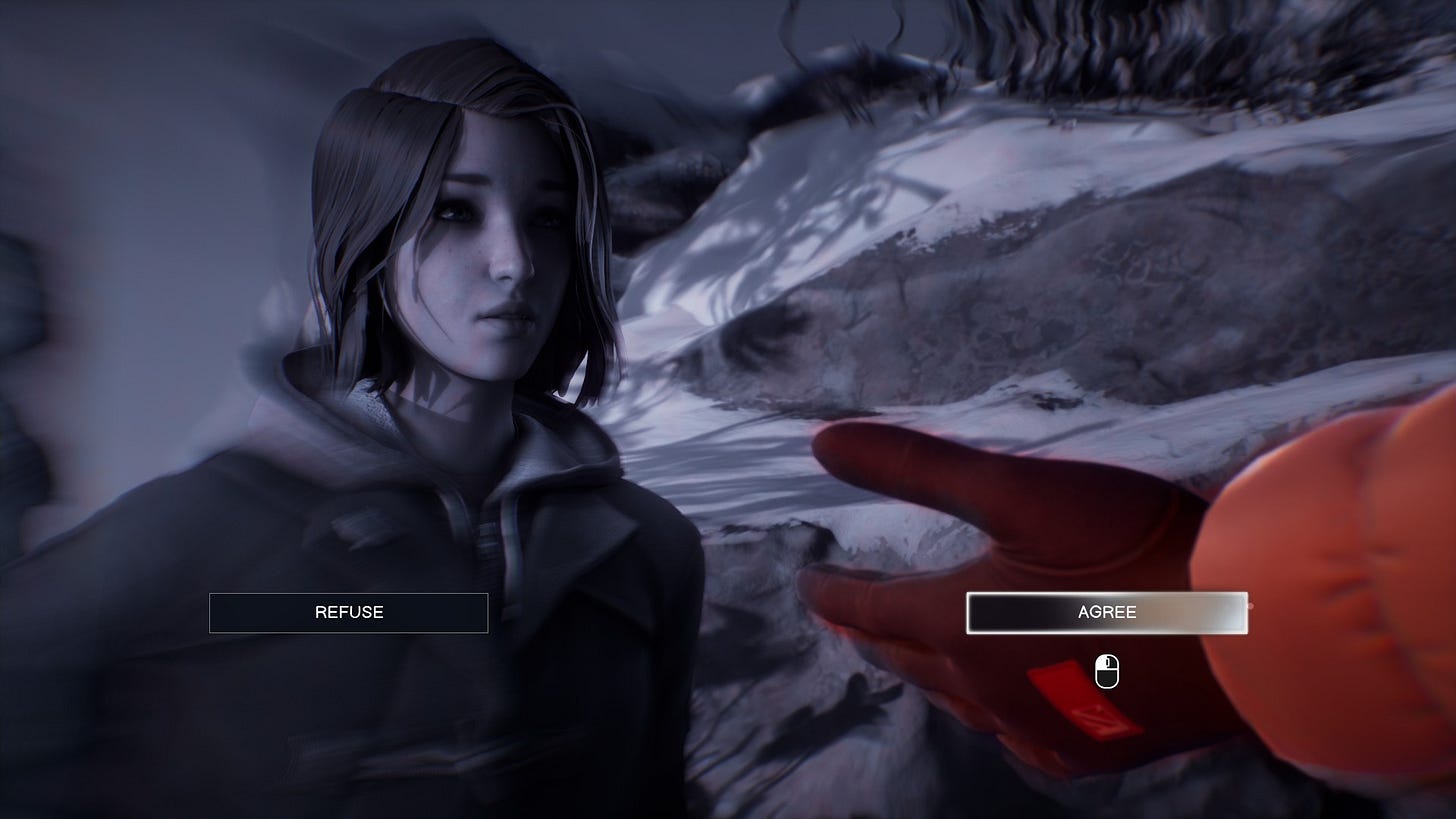A Review of Life is Strange: Double Exposure
Max Caulfield’s long-awaited return feels like a second-rate copy.
At the end of the adventure video game Life is Strange (2015), Max and Chloe look on from the edge of a cliff as a catastrophic cyclone barrels towards their hometown of Arcadia Bay. It’s a haunting vision that just a week prior, when the game began, Max dreamed of in class. Her family had moved away from Arcadia Bay years ago, and she’d only recently returned to attend a prestigious arts academy there. Afterwards in the bathroom she witnesses a murder, and in a sudden effort Max inexplicably gains the power to rewind time and prevent it. She discovers who she saved was Chloe Price, her childhood best friend she’d lost touch with when she moved away. The reunited pair spend the week exploring the interconnected mystery of the attempt on Chloe’s life and the recent disappearance of Chloe’s close friend Rachel, whose haunting missing posters litter the town. Death continues to relentlessly torment Chloe, as she dies in a multitude of ways only to be saved each time by Max’s rewind power. With each new timeline Arcadia Bay descends further into paranormal madness before finally culminating in the cyclone. On the cliff Chloe pleads with Max to go back in time to the school bathroom and allow her to die by never using her powers, restoring fate and preventing the storm. In a game riddled with hundreds of choices, the player is left with only two; sacrifice your best friend, or your hometown and everyone in it.
This gut punch of an ending cemented Life is Strange as a cult classic that was immensely innovative for its time. I became one of this game’s many die-hard fans, perhaps because I first played it during the formative time of adolescence, when I could deeply relate to the awkward, emotionally turbulent growing pains the teen characters were going through. Nevertheless, the game became both a critical and commercial hit, and today it’s considered a trailblazer in interactive narratives.
Life is Strange soon became an anthology series, with each installment featuring new settings and characters but keeping the structure of a personal, intimate story with a supernatural twist. The first two titles were created by French developers DontNod, who had sold all rights to the franchise to Japanese publishing company Square Enix in order to get their games distributed. In 2019 DontNod ended the partnership in order to self-publish their games, and Square Enix placed the future of Life is Strange in the hands of American developers DeckNine. The entries under this new ownership were met with fairly positive reviews but noticeably less acclaim than DontNod’s works.
Then, in 2023, a trailer dropped that shook the dormant fanbase of the franchise awake. It was for Life is Strange: Double Exposure, which revealed that for the first time in 10 years players would once again follow Max, now a decade older and a resident artist at a university. One night she finds her friend Safiya murdered on campus, and although her rewind powers haven’t worked in years, she’s now able to enter an alternate reality where Safiya is still alive. Max must then use both realities to investigate Safiya’s death and save the version of her she still has left.
It was an intriguing premise, albeit pretty similar to the original’s (put a pin in that, because there’s a lot more where that came from). While Max’s voice actress would return, the game was being made by an entirely different creative team than the original, one with a worse track record of Life is Strange entries. So, while I had concerns, I was still flooded with nostalgia when I saw that trailer, and had high hopes it would be a worthy continuation of such a beloved story.
Previously one would assume the franchise had to be an anthology, because one of its main selling points is that the player has agency within the game’s world and can shape the arc of the story through their choices. This put Double Exposure in a tricky spot from the get-go, because as soon as Max’s return was announced the immediate question in my mind was how a sequel could be made to a game with two starkly different endings.
My more utilitarian sensibilities led me to sacrifice Chloe all those years ago, so my playthrough of Double Exposure began with Max still grieving and guilty over her death. If you sacrificed Arcadia Bay, Max is saddled with the same feelings but surrounding that tragedy instead. So, what happened to her and Chloe in this timeline? Well, you soon find out Chloe left Max a few years after the events of the first because Max was unable to move on from the past. Max can still text her throughout the game on amicable terms, although that’s pretty much the extent of their interactions.
People did not take well to this. Their relationship was the core of the first game, so an offscreen breakup after Max sacrificed hundreds to keep her alive quickly led fans to decry the sequel as a betrayal of its source material. I was one of the few fans not vehemently opposed to this, as I’d already figured the only way to feasibly make this sequel would be to have Max from both endings end in fairly similar circumstances a decade later. If anything, I thought it was inevitable for Max and Chloe's tumultuous teen relationship to eventually end, especially with their guilt of the lives it cost. I hoped this could set Max up for an interesting character arc of learning to accept and move on from the past, as just from the trailer you could tell she’d grown from the timid wallflower we’d known her to be.
I wanted to judge this game not as mere fan service to its predecessor, but as its own game with a fresh story to tell. Unfortunately, it insisted on being a rehash.
Near the end of Life is Strange, it’s uncovered that Mr. Jefferson, a beloved photography teacher at Max’s school, had been drugging and photographing female students for his perverted project of capturing vulnerability. He was helped by the affluent schoolboy who nearly shot Chloe, who months ago accidentally killed Chloe’s best friend Rachel with an overdose. Taking Jefferson down is a heart pounding mission that involves Max and Chloe gathering and connecting evidence across town, which results in Max becoming his captive and having to desperately travel through different timelines to save herself.
Near the end of Double Exposure, it’s uncovered that years ago Mr. Colmenero, a beloved writing professor at Max’s school, plagiarized a manuscript from a student named Maya, Safiya’s best friend. This launched him to literary fame and drove Maya to suicide. You conveniently find proof of this in his office, and once Max reveals this to the school community he’s unceremoniously fired.
Of course, it’s common for a sequel to have similarities with their predecessors, but in this case, it just highlights how the original did each aspect better. Rachel’s magnetic yet volatile character is gradually revealed throughout the first game, while Maya isn’t even introduced in the second game until halfway through and simply remains a blank slate, dead victim you feel zero connection to. This loss of depth and stakes makes the quest for justice in Double Exposure a far weaker experience.
In each Life is Strange title you have the ability to form romantic relationships, which is another facet that this game bungles. The love interest Amanda (I just had to look up her name if that’s any clue on her memorability) is simply…nice. Your bland romance with her is pretty much pushed on you from the beginning of the game without any natural buildup, and at the end of the game no matter your choices the two of you decide to just be friends.
What made Chloe such a compelling love interest was that she was so much more than that. Not only is it the player’s choice in whether or not Max’s relationship with her stayed platonic or became something more, but she was allowed to be an incredibly flawed character. She’s introduced as a brash and bitter high school dropout, hardened by her father’s death, Max’s abandonment, and Rachel’s disappearance. Yet rekindling her friendship with Max brings back her childhood warmth and pushes her to take accountability for her life instead of shoving the blame on everyone around her. The original creators didn’t feel the need to sanitize Chloe simply because portrayals of queer women were so sparse, and her potential romance with Max is far more authentic and interesting representation because of it.
You might be wondering by this point why I haven’t really touched upon the central plot line of the game, which is investigating Safiya’s murder. Frankly, that’s because I struggle to coherently criticize writing that itself fails to be coherent. Don’t get me wrong, I’ll be the first to admit that the first game had its fair share of flaws. There’s a few time travel plot holes, but in particular its dialogue, written by two middle-aged French men, has become infamous for its attempt at teenage slang (though I'd argue the cringe is part of the charm). I don’t have much issue with the dialogue in the new game, it’s often quite strong, but the nonsensical convolution of the overall plot makes it seem like each chapter was written by a different writer in a bizarre game of telephone.
Throughout her investigation, Max encounters a number of strange phenomena that often seem like they were only thrown in to heighten the mystery without actually having any reasoning behind them. Flowers sprout from where Safiya’s body was found (this is never explained), polaroids littered town seem to capture an secret third timeline (this is also never explained), a secret society at the school undergoes a tense election (this never amounts to anything), and you witness a detective touch the version of himself from the other timeline and disappear from existence (although you conveniently never find an alternative version of yourself). It’s framed as a significant choice as to whether or not you try and save him from this fate, but either way you never see him again and this is never resolved.
Most puzzling of all, the last photo on Safiya’s camera in the universe where she died is of Max pointing a gun at her, which sends Max (and players) into utter confusion on how she could be the killer.
Max finds multiple professors implicated in separate incidents they did not commit and later discovers that Safiya has shape-shifting powers she used to impersonate them and sabotage their lives as revenge for wronging her and her late best friend Mya. Safiya then learns out it was her own mother, the university president, who orchestrated the cover up of Mya’s real reason for suicide and the killing of Safiya’s book deal mentioning this incident, so she naturally reacts by shooting her own mother (I like a heavily flawed character, but this just crosses the line into straight-up villainy).
Safiya’s powers spiral out of control as she possesses everyone on campus (which wasn’t an established power of hers), and Max uses her rewind power to take both of them back to the day Safiya was supposed to die. Safiya begs Max to shoot and kill her to end the chaos, but Max refuses (which then begs the question…if the trigger was never pulled, how was Safiya shot??). This merges the two timelines and frees everyone from the control of Safiya, who is now abruptly back to being unremorseful for some reason and decides to flee and seek others with powers.
She asks Max to wait for her return and help her harness her abilities (her shot mother is still there just…watching this), and the big final choice of the game is whether Max chooses to accept or deny this request. The game hasn’t really given you the time to form a particularly deep connection with her (not to mention a lot of compassion you may have had for her probably dissolved when she shot her own mom), and there don’t seem to really be any stakes in your choice. Either way she goes off into the night, and Max anticlimactically tells the rest of her friends what happened.
The Life is Strange games have always been defined by allowing players to follow their own path in the story, yet no matter what decisions you make throughout the Double Exposure you essentially get the same ending. When compared to the captivating dilemma that the first game’s final choice presented, this all just feels both bland and bewildering.
What makes this ending even worse is the post-credits scene, in which a random side character we barely know seems to also be getting powers and Safiya reappears out of the blue to tell her to come with her. “MAX CAULFIELD WILL RETURN flashes on the screen before the credits roll, and I’m left baffled why a franchise renowned for its personal, intimate stories is now trying to be an X-men rip-off.
The first game’s game mechanics were hardly its greatest strength, often having unintuitive time travel puzzles, but this game takes the ingenious mechanic of alternative realities and mostly uses it for tedious fetch quests (i.e. need a stool to reach something, grab one from the other reality, bring it back). There are brief moments of creative design, such as when Max gains the ability to "entangle" objects between timelines, but this was only utilized twice before being promptly forgotten.
If this wasn’t all mind-numbing enough, Max incessantly delivers “hints” by telling herself precisely what she needs to do, spoiling any sense of discovery or satisfaction on the part of the player. This often overlaps with Max’s typical inner monologue, her response to clicking on an object, and the conversations she overhears, resulting in the screen sometimes becoming an incomprehensible wall of subtitles.
The one way that this game is definitively a step up from the previous is the visuals. The animation is top tier, allowing the characters to have nuanced facial expressions the first game could’ve only dreamed of having. These really shine in the game’s often stunning cinematics, which when bolstered by the consistently strong score and voice acting truly become the game’s best feature.
But while the world is undeniably gorgeous, it feels claustrophobically small. You visit the same handful of areas over and over, which would be fine if the game wasn’t twelve hours long. The original game had more blocky, low poly visuals, yet the far greater number of places you got to explore made it feel like a much more fleshed-out world. Each location may be in stunning high definition in Double Exposure, but they nonetheless begin to feel stale when you’ve seen them a dozen times before.
The few moments when the game really shines is what makes the overall experience so much more frustrating, because you can clearly see that there was genuine care and attention put into parts of this game. DeckNine faced significant challenges during its development of Double Exposure, with twenty percent of its team being laid off in the midst of releasing episodes. With this context and the fact that the game was made linearly, it begins to make more sense why the game started out somewhat promising before taking such a nosedive into completely dropped plot lines and lazy absurdity.
Not long after the release of Double Exposure, Life Is Strange’s original creators DontNod released their new original game Lost Records: Bloom and Rage (2025). As I became immersed in their new world and interacted with far richer characters and more competent writing than Double Exposure had to offer, it felt so much more like a return to the original Life is Strange despite this title having no formal connection to it. It was comforting to know that even though the Life is Strange franchise I once loved seems headed towards an unfortunate end, the magic of the original game can be reproduced through other means.
You might expect me to conclude by saying you shouldn’t waste your time playing this game, but I hesitate in doing so. For those of you like me who have a deep attachment to the original game and were elated to step back into Max’s shoes and see what was next in her story, there are aspects of this game to enjoy. But nostalgia can only go so far, so if you go in hoping to reach anywhere near the highs of the original, you’ll probably be left wanting to rewind.
















